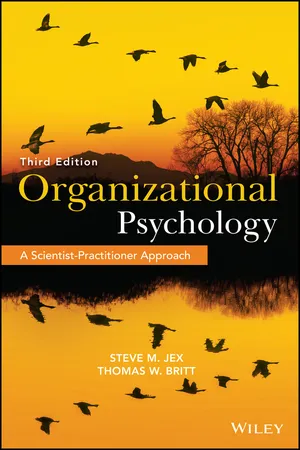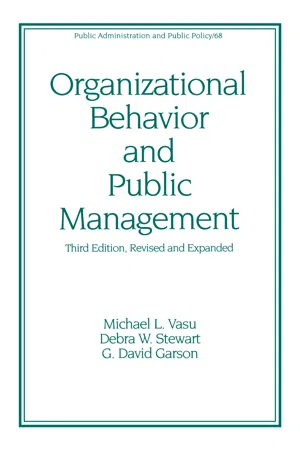Business
Modern Motivational Theory
Modern motivational theory in business emphasizes the importance of intrinsic motivation, focusing on factors such as autonomy, mastery, and purpose. It recognizes that individuals are driven by more than just financial rewards and seeks to create a work environment that fosters engagement and fulfillment. This approach acknowledges the diverse needs and motivations of employees, aiming to enhance productivity and satisfaction.
Written by Perlego with AI-assistance
Related key terms
8 Key excerpts on "Modern Motivational Theory"
- eBook - ePub
Organizational Psychology
A Scientist-Practitioner Approach
- Steve M. Jex, Thomas W. Britt(Authors)
- 2014(Publication Date)
- Wiley(Publisher)
Cognitive process theories are aimed at describing the cognitive processes involved in employee motivation. These theories, for example, focus on things such as decision making, levels of aspiration, and self-regulation. Theories discussed under this category included Equity Theory, Expectancy Theory, Goal Setting, and Control Theory. Although all of these theories have been supported, Goal Setting has clearly received the greatest support and has had the most impact within organizations. In the future, as cognitive process theories become more complex, a challenge will be to translate these into a form that can be readily used by managers.The Behavioral Approach to employee motivation involves using principles adapted from behaviorism in order to influence behavior in organizations. The principle used most frequently is reinforcement, although others, such as punishment, shaping, and extinction, may be used in certain situations. Applications of the behavioral approach in organizations, in the form of Organizational Behavior Modification (OBM), have produced impressive results. This approach, however, appears to work best in situations where the jobs being performed are not highly complex.Self-Determination Theory emphasizes the importance of not only the quantity, or amount, of motivation, but the quality of that motivation. Proponents of this theory state that employees driven by autonomous motivation at work will be more satisfied and perform better than employees who experience their behavior as controlled by others. This theory has received a great deal of support outside of the organizational context, and will likely be applied to organizational psychology in coming years.According to job-based theories, the content of employees' jobs is the key factor influencing motivation. Theories covered under this category included Herzberg's Motivation-Hygiene Theory, Job Characteristics Theory, Campion's Interdisciplinary Approach to Job Design, and most recently Grant's Relational approach to job design. Job-based theories have proven quite useful and have generally been supported much better than need-based theories. One problem that plagues job-based theories is the distinction between objective and subjective attributes of jobs.In the concluding portion of the chapter, we examined the value of motivation theories to managers in organizations. This may vary from theory to theory, but it was concluded that in general, motivation theories can be quite useful to managers. Specifically, theories provide managers with a “road map” for motivating employees. Without motivation theories, managers would be forced to rely entirely on intuition and their own implicit theories of human behavior. We continue to explore the importance of motivation in the next chapter as we examine the specific tactics used by organizations to influence employee motivation. - eBook - ePub
Performance Management
Measure and Improve The Effectiveness of Your Employees
- (Author)
- 0(Publication Date)
- Harvard Business Review Press(Publisher)
2Motivation
The Not-So-Secret Ingredient of High PerformanceKey Topics Covered in This Chapter- Theories of motivation
- Intrinsic and extrinsic rewards
- The messy problem of incentive systems
- Ten motivational practices
M OTIVATION IS THE next important piece of managing employee performance. It is, in fact, at the very heart of performance management—something that managers must attend to all the time. A person can understand goals and why they are important, but must also be motivated to pursue them. You can coach this same person to close performance gaps and improve productivity, but the employee won’t take that coaching to heart if he or she is uninterested or unmotivated. You can spend hours on someone’s annual performance appraisal and have a productive chat about it, but again, those hours will be wasted if the employee isn’t motivated to improve.This chapter explains some of the key theories of workplace motivation and the impact of rewards and incentives. It offers a number of things you can do to motivate the people who work for you.Theories of Motivation
The principles of effective motivation have a long history. Although we tend to mark the beginning of that history with the Industrial Age, leaders and managers of every age undoubtedly understood the importance of motivation and probably experimented with different ways of inspiring it.The classic theories of industrial management and organization were formulated in the late 1800s and early 1900s. These theories were less concerned with worker motivation than with the mechanisms of efficiency, predictability, and control. A business was conceptualized as a machine for producing goods and services, and people were simply among the parts of that machine. Frederick Taylor (1856–1915), credited as the father of scientific management, defined work in terms of coordinated, highly specified tasks designed for optimal efficiency, with little or nothing left to the judgment of production-line employees. This approach to work was supported by a particular view of human nature—or, should we say, the nature of industrial workers. In this view, employees were lazy and untrustworthy creatures. They could be motivated only by pay and the fear of dismissal and unemployment. Years later, Douglas McGregor would enshrine this view of human nature in what he called the Theory X approach to management.1 - Betty Jane Punnett(Author)
- 2018(Publication Date)
- Routledge(Publisher)
Chapter 7Motivation and Organizational Behavior in an International Context
LEARNING OBJECTIVES
The purpose of this chapter is to consider motivation and how it may differ from one location to another. Specifically, the chapter will:- • Define and discuss the broad concept of motivation;
- • Explain why it is difficult to understand what motivates people, especially in different contexts;
- • Introduce and explain the major western theories of motivation;
- • Consider needs, equity, rewards, expectations, goals, and delegation/participation and how they relate to motivation;
- • Examine each of the motivation theories in the context of differences around the world, including cultural differences, and the impact of millennials at work;
- • Explore the aspects of motivation theories that seem to be universal as well as those that seem to be culturally contingent;
- • Make suggestions about how managers can assess and address motivation in different contexts.
Introduction
Motivation refers to the inner urges that cause people to behave in certain ways rather than the behavior itself. In the workplace, we talk of people being highly motivated when they work hard to accomplish objectives that are consistent with the organization’s goals. In this case, we observe the behavior, but we cannot observe the cause(s) of the behavior. We talk of people being de-motivated on the job when they seem disinterested and need to be pushed to perform. What makes people motivated or de-motivated at work is complex because motivation is caused by a mix of psychological (e.g., introversion/extroversion, self-esteem) and demographic (e.g., age, gender, ethnicity) characteristics.It is not really accurate to talk of people being de-motivated. People are always motivated in some direction; the question is the direction of their motivation. When someone is de-motivated at work, it means that they are motivated in some non-work direction; that is, they would rather be doing something other than work. Nevertheless, the terminology of de-motivation is used frequently in everyday language, so it will be used in this chapter. When we say that someone is de-motivated, then, we mean that they are not working very hard, and their performance is less than could be expected. This is why motivation and its causes are of such interest to managers. A firm’s success and profitability are directly related, to a large extent, to the performance and productivity of the people who work for the firm; thus, a major component of a manager’s role is to ensure that employees are performing at a peak level.- eBook - ePub
The Psychology of Behaviour at Work
The Individual in the Organization
- Adrian Furnham(Author)
- 2012(Publication Date)
- Psychology Press(Publisher)
6 Work motivation and satisfactionIntroductionOne of the oldest, and most difficult, topics in psychology is the fundamental problem of why people are motivated to do anything at all, and if they do something, why that and not something else. Managers and researchers talk of goals, incentives, needs, reinforcers and rewards, and it is clear that there are many definitional problems. The question is why people choose, or not to choose, to do something, how much effort they put into it, and how persistent they are in trying to achieve it. The issue is really twofold: the nature of the driving force (where it comes from; what are its properties) and the direction and maintenance of the drive (what effects does it have on individual behaviour). As Greenberg and Baron (2003) note, motivation and job performance are not synonymous; motivation is multi-faceted, people are motivated by more than just money. These problems have intrigued and fascinated psychologists and managers of all persuasions for a very long time. Indeed, there are so many approaches and theories in this area that most reviewers have attempted to classify or taxonomize them into groups, such as need reduction theories, expectancy value theories and mastery/growth theories.Motivation is a hypothetical construct which refers to a set of multiple internal processes with multiple consequential behaviours. It is goal directed. Motivational processes result from certain things about the individual: ability (job knowledge), dispositions (stable traits), beliefs and values, and affective mood state. These are also related to an individual’s skills. However, motivation is also closely related to job context: the nature of the task/job, the physical environment, implicit and explicit rewards (reinforcements), social norms and the wider corporate culture. These factors also relate to how easy or hard it is to do the job. Thus individual factors and job context together determine motivational processes that affect a person’s effort, persistence, attention and task strategy. Thus motivational processes lead to intentions that result in behaviour, but these are highly dynamic and change over time (Mitchell & Daniels, 2003). - Colin P. Silverthorne(Author)
- 2005(Publication Date)
- NYU Press(Publisher)
7Work MotivationThe impact of motivation on work performance has been of considerable interest to researchers for many years. Since the role of work in a society reflects the values of that society, work motivation is also presumably influenced by cultural issues. Managing across cultures requires motivating employees from various cultures, but finding a framework for motivating and managing behavior across cultures has proven difficult (Adler and Doktor, 1989). Overall, the evidence for the impact of culture on motivation is primarily experiential and anecdotal rather than research based.What Is Motivation?
Theories of motivation can be categorized into two primary schools of thought: content and process. Theorists such as A. H. Maslow (1943), F. Herzberg (1966), and D. McClelland (1976) developed what are known as content theories, in that they emphasize what motivates an individual. In contrast, Vroom (1964) and Locke (1991) proposed theories that emphasize how an individual is motivated to behave. These are known as process theories.In an attempt to pull together the different theories and approaches to work motivation, Locke (1991) noted that content and process theories are not necessarily different. Rather, they address different aspects of the motivational sequence. He proposed that motivation be looked at as having a motivation core and a motivation hub. The model begins as a need theory and then moves to values and motives, which are the core of the motivation. Need theories, as proposed by Maslow and others, start with the assumption that people have a variety of needs that have to be met and that motivation is driven by the desire to satisfy those needs. Values and motives, which fit into the theories of Vroom and others, shape how we attempt to meet our needs. The hub of motivation includes goals, intentions, and expectations. As the hub is fulfilled, rewards are gained and satisfaction is achieved.- Michael L. Vasu, Debra W. Stewart, G. David Garson, Michael L. Vasu, Debra W. Stewart, G. David Garson(Authors)
- 2017(Publication Date)
- Routledge(Publisher)
Behavior needs to be tied to reinforces. These reinforcers may be symbolic, explicit praise, or tangible pay for specific levels of measured performance.Motivation in the Workplace
The preceding review of basic motivation theory provides the conceptual building blocks for models predicting and analyzing motivation on the job. Like the theories of motivation put forth above, research on employee motivation falls into two broad categories: (1) research focusing on how changes occurring in the worker yield changes in behavior (rooted in cognitive theory): and (2) research asking how reinforcement of behavior itself yields changed behavior (rooted in acognitive theory). Each of the approaches in the cognitive tradition gives rise to distinctive prescriptive models for motivating employees.Applications Deriving from the Cognitive Tradition
Theory X, Theory Y, Theory Z
The first model stemming from the human growth development approach is the previously mentioned Theory X, Theory Y analysis of motivation by Douglas McGregor. Douglas McGregor, in his classic work, The Human Side of Enterprise (1957), builds a theory of work motivation premised on the humanistic psychology of Abraham Maslow.There are at least five sets of goals which we may call basic needs. These basic goals are related to each other, being arranged in a hierarchy of prepotency. When a need is fairly well satisfied, the next prepotent (“higher”) need emerges, in turn to dominate the conscious life and to serve as the center of organization of behavior, since gratified needs are not active motivators (Maslow, 1943).Accepting this analysis of human nature with needs arranged from physiological, to safety, to social, to ego, to self-actualization in ascending order of potency, McGregor criticizes conventional managerial theory for making incorrect assumptions about the management process. According to McGregor, conventional management theory, or Theory X, believes that without active intervention by management, people would be passive, even resistant, to organizational needs. Theory X sees the average person as indolent by nature, lacking ambition, disliking responsibility, and preferring to be led. The typical employee is inherently self-centered, indifferent to organizational needs and by nature resistant to change (McGregor, 1957). In effect, they are at best motivated by the lower levels of the needs hierarchy. McGregor argues that the Theory X philosophy confuses cause and effect in its analysis of human nature. If the employee in the modern organization is the passive indifferent actor described above, it is in response to existing management philosophy, policy, and practice. He is “sick” because of deprivation of a higher level need. This sickness has the behavioral consequences outlined above. While the contemporary organization meets the physiological and safety needs of most employees, social needs are viewed by management as a threat to the organization so the organization seeks to inhibit them.- eBook - ePub
Performance Management Systems
A Global Perspective
- Arup Varma, Pawan S. Budhwar, Angelo DeNisi, Arup Varma, Pawan S. Budhwar, Angelo DeNisi(Authors)
- 2023(Publication Date)
- Routledge(Publisher)
First, one will be more motivated to put forth effort if they believe that they can achieve high performance through hard work. A range of factors may contribute to employees’ expectancy perceptions, including employees’ abilities, skills, knowledge, the support and resources that they have access to, and personality traits, including self-efficacy and locus of control. For instance, when an employee is assigned a task that is far beyond their ability, their motivation level will suffer because they think they will not be able to complete the task no matter how hard they try. Or, if an employee lacks the necessary resources or equipment tools to achieve high performance, they may simply withhold their effort. Similarly, when an employee has an external locus of control (i.e., a general expectancy that performance is dependent on uncontrollable factors such as luck), or low self-efficacy (i.e., not confident in their ability), expectancy is likely to be low. Thus, organizations wishing to strengthen employees’ expectancy perceptions can benefit from a variety of practices, such as delegating tasks with moderate difficulty levels, providing continuous feedback to help employees improve their performance, and offering training opportunities to improve their knowledge and skills. Apart from expectancy, one will be motivated to put more effort when they believe high performance will lead to rewards. As such, it is important for organizations to link rewards to performance and make sure employees are aware of the connections. Finally, employees are more likely to be motivated when the rewards associated with high performance are personally attractive. If a high-performing employee values work–life balance and hopes to get a weeklong paid vacation but the organization rewarded them with more responsibilities and authority instead, this employee might find the reward undesirable (i.e., the valence is negative) and might withhold efforts in the future. Therefore, managers are advised to find out what their employees value via surveying them or talking to them directly. It might also be a good idea if employees have the option to choose the rewards that appeal to them among several equivalent ones.To summarize, the basic premise of process-based theories of work motivation is that employee motivation is a rational process – employees cognitively process their surrounding environment, and react in certain ways to maximize the expected payoff. It is worth noting that equity theory and expectancy theory are particularly useful to help organizations motivate employees through performance management.Goal-Based Theories of Work Motivation
A goal represents something that an individual attempts to attain or achieve; it is the aim of an individual’s behavior (Locke & Latham, 2002 ). Goal-setting theory (Locke & Latham, 1990 , 2002 ) is one of the most important and influential theories of work motivation, which has received numerous empirical supports across employees from varied industries (Miner, 2003 ). The fundamental tenet of this theory is that goals guide human behavior. There is strong support that, in the workplace, setting appropriate goals can help enhance employee performance to a large extent (Latham & Locke, 2006 ; Pritchard, Roth, Jones, Galgay, & Watson, 1988 ).The second major tenet of goal-setting theory is that challenging or difficult goals lead to higher levels of performance than easy goals. Meta-analytic evidence shows that when goals are challenging and aggressive, employees tend to work harder or smarter, leading to higher levels of both individual and group performance (Kleingeld, van Mierlo, & Arends, 2011 ; Steel & Karren, 1987 ). At first glance, the goal difficulty tenet of goal-setting theory is contradictory to expectancy theory; the latter seems to suggest that easy goals can enhance employees’ expectancy perception, resulting in higher levels of motivation. To solve this apparent contradiction, Locke and Latham (2002) - eBook - ePub
Performance Management
Theory and Practice
- Susan Hutchinson(Author)
- 2013(Publication Date)
- CIPD - Kogan Page(Publisher)
This chapter has considered some of the key theories on motivation and their relevance for performance management practice. Although there is no one universally accepted theory on motivation, there are an enormous number of established studies. All offer different perspectives and insights, and despite their shortcomings (and age) they remain highly influential. The chapter has considered what are called content theories, which try to explain the ‘what’ of motivation by focusing on needs that shape motivational action. Although each theory has its own view on which needs are most important, they can best be viewed as complementary. For example, Maslow and Alderfer’s theories are closely related in viewing a hierarchical ordering of needs. Herzberg’s hygiene factors are similar to Maslow’s psychological, safety and affiliation needs, and Alderfer’s existence and relatedness needs. Herzberg’s motivators are broadly comparable with Maslow’s higher-order needs, with growth in Alderfer’s model, and power and achievement in McClelland’s theory. One of the most important contributions these models make is to distinguish between extrinsic and intrinsic motivators. They also highlight the influence of the nature of the job and the importance of job design. However, these theories also share some shortcomings. They mostly adopt a universal perspective and assume that people have a common set of needs, ignoring individual differences and the impact of contextual factors such as national and organisational culture.The chapter also considered the process theories which look at the cognitive processes to try to understand the ‘why’ of motivation. They are not grounded in the assumption of universality, and place emphasis on individual differences. In the main, the basic tenets of these theories remain unchallenged (Ambrose and Kulik, 1999: 278). They highlight the importance of managing expectations and fairness, similar to the psychological contract (Chapter 1
Index pages curate the most relevant extracts from our library of academic textbooks. They’ve been created using an in-house natural language model (NLM), each adding context and meaning to key research topics.







